
2025 Nov. 20 Introduction of LAF50

Optical glass for polished lenses
We are releasing LAF50 (nd=1.60199, νd=50.21), which has extremely high anomalous dispersion in the near-infrared region.
With a specific gravity of 2.93, this glass has been designed with consideration given to both optical properties and specific gravity.
It can be used in a wide range of applications, including cameras and interchangeable lenses that use near-infrared light.
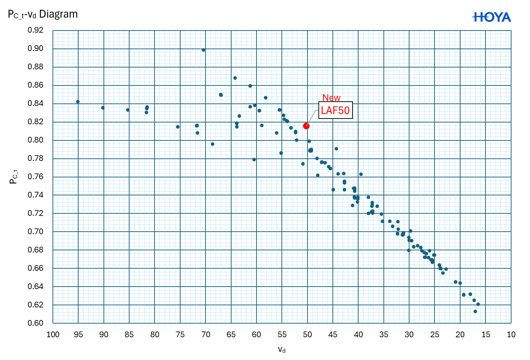
2025 Sep. 01 Excel Catalog Update

| Glass Type |
Update |
| M-NBFD10, MP-NBFD10-20 |
Glass type classification change:
" " general ⇒ "◎" recommended |
| M-PCD55AR, MP-PCD55AR |
Glass type classification change:
"◎" recommended ⇒ " " general |
| PCD51、MC-PCD51-70 |
λ5(270→265), λτ80(330→327), λτ5(268→265)
τ380~280 |
| M-PCD51, MP-PCD51-70 |
λ5(270→265), λτ5(270→263)
τ360~280 |
| M-BACD12, MP-BACD12 |
λ80(345→340), λ5(285→280), λτ80(332→329), λτ5(284→279), CCI(G)(0.22→0.21), CCI(R)(0.22→0.21)
τ400~280 |
| MC-BACD12 |
λ5(285→280), λτ80(330→328), λτ5(285→280), CCI(G)(0.18→0.17), CCI(R)(0.18→0.17)
τ400~280 |
| MC-TAF101-100 |
λ5(285→280)
τ380~280 |
| M-TAF105, MP-TAF105 |
λ5(290→285), λτ80(349→348), λτ5(283→284), CCI(G)(0.49→0.47), CCI(R)(0.51→0.49)
τ400~280 |
2025 Jun. 23 Introduction of TAFD25L

Optical glass for polished lenses
Cost reduction has been achieved by reducing the amount of expensive rare metal raw materials.
nd and vd are the same as the conventional TAFD25. (nd:1.90366 νd:31.32)
Low specific gravity compared to TAFD25, which is advantageous for reducing the weight of optical systems.

2025 Jun. 23 Introduction of MC-NBFD130L

Optical glass preforms for aspheric lenses
Cost reduction has been achieved by reducing the amount of expensive rare metal raw materials.
nd and vd are the same as the conventional MC-NBFD130. (nd:1.80610 νd:40.73)
Tg is approximately 20°C lower than MC-NBFD130. GMO press molding temperature can be lowered.
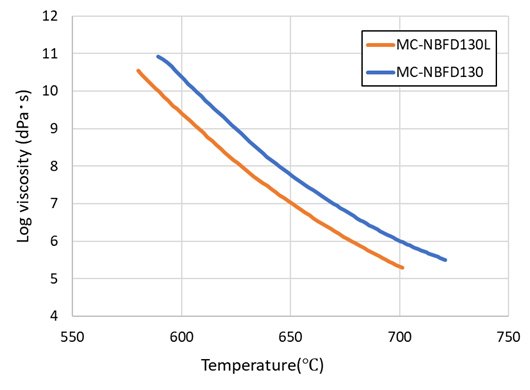
2025 Jun. 02 Introduction of FD300

Optical glass for polished lenses
We are releasing high dispersion glass FD300 (nd=1.62423, νd=30.05).
The PgF is 0.6228, which is higher than conventional glass types.
It has high dispersion and a low temperature coefficient of refractive index.
dnd/dT(20-40℃)=-4.4×10-6 (Compare E-FD15L(νd=30.05) dnd/dT= 2.5×10-6)
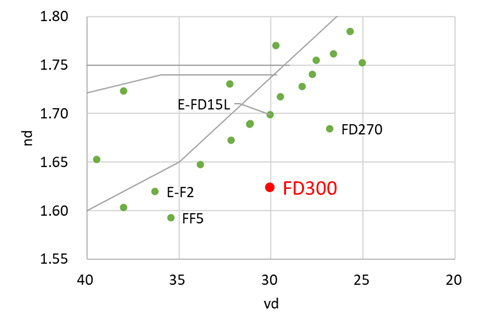
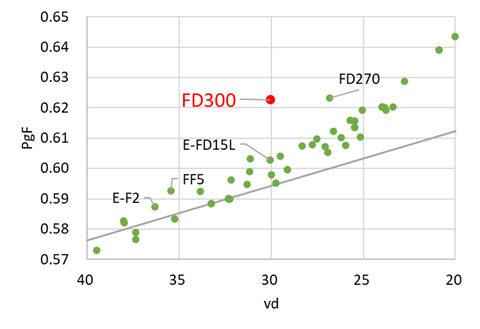
2025 May. 12 Introduction of TAFD75-W

Optical glass for polished lenses
TAFD75-W is a new material that features high transmittance while having a high refractive index exceeding nd=2.10.
In addition to lens applications, this glass is also suitable for AR/MR waveguides with a wide FOV.
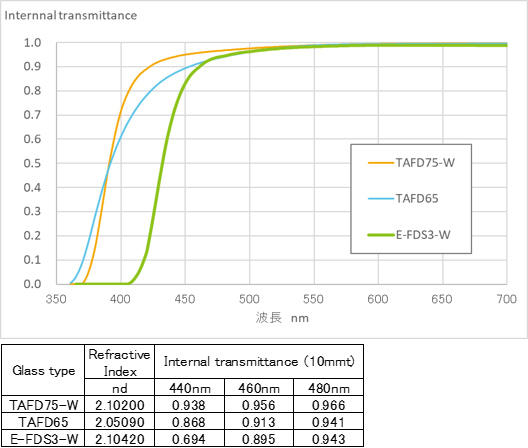
2025 Apr. 10 Introduction of TAC6L

Optical glass for polished lenses
Cost reduction has been achieved by reducing the amount of expensive rare metal raw materials.
nd and vd are the same as conventional TAC6. (nd:1.75500 νd:52.32)
2024 Nov. 08 Introduction of NBFD26

Optical glass for polished lenses
NBFD26 (nd=1.83401, vd=25.97) has been added to the NBFD series, which is characterized by its low partial dispersion.
It features a PgF of 0.6076, which is lower than NBFD25 (PgF=0.6103).
There are no shape restrictions like NBFD25.
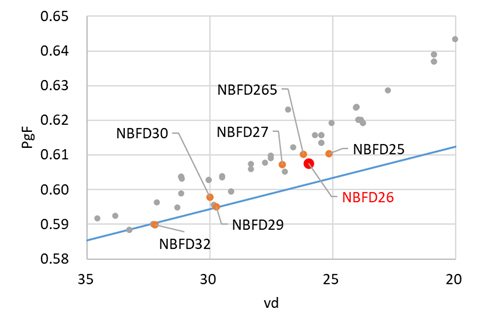
2024 Jun. 14 Introduction of MC-TAF115

Optical glass preforms for aspheric lenses
MC-TAF115 (nd=1.77047, vd=49.46) is a glass that improves on the GMO press formability of MC-TAF105.
MC-TAF115 has a Tg that is approximately 20°C lower than MC-TAF105.
It also has the same specific gravity as TAF1 (specific gravity = 4.28).
By reducing the use of expensive rare metal raw materials, we have also succeeded in reducing the cost of the glass.
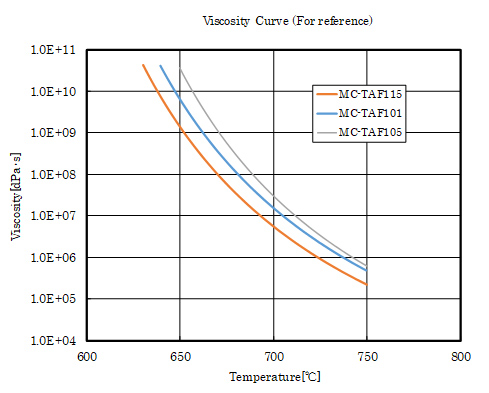
2024 May. 01 Introduction of TAF48

Optical glass for polished lenses
We will release TAF48, which has a higher refractive index (nd=1.79) and Abbe number (vd=48.1) than TAF4, which is a medium refractive index and low dispersion glass.
We have successfully reduced the cost of glass by reducing the amount of expensive rare metal raw materials.
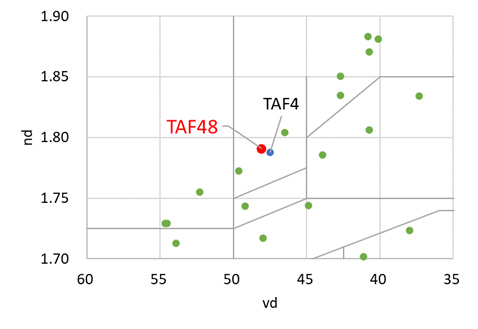
2024 May. 01 Introduction of FDS165-W

Glass for AR/MR waveguide & Optical glass for polished lenses
FDS165-W (nd=1.98611, vd=17.25) is a glass with consideration for transmittance and specific gravity in the high refractive index and high dispersion region.
Internal transmission at 460nm is over 95%.
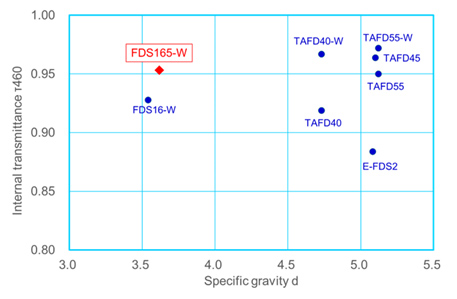
2024 May. 01 Introduction of MC-TAFD317

Optical glass preforms for aspheric lenses
MC-TAFD317 (nd=1.88120, vd=37.17) is a glass with improved GMO press formability of MC-TAFD307.
Tg is approximately 20℃ lower than MC-TAFD307.
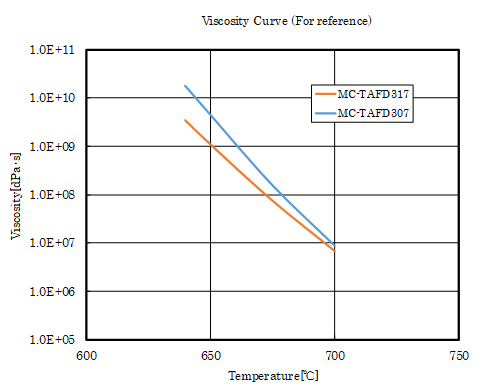
2024 Mar. 18 Introduction of TAFD45L

Optical glass for polished lenses
We have achieved lower costs by reducing the use of expensive rare metal raw materials.
nd, vd, coloring code is the same as conventional TAFD45. (nd:1.95375 νd:32.32 λ70/λ5:405/355)
2024 Mar. 04 Introduction of NBFD265

Optical glass for polished lenses
We will introduce NBFD265 (nd=1.95203, vd=26.20), which has the highest refractive index in the NBFD series, which is characterized by partial dispersion.
PgF is 0.6101, which is close to NBFD25 (PgF=0.6103).
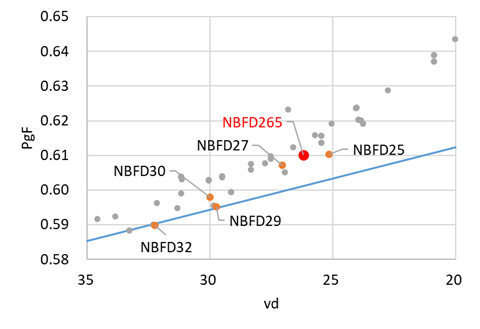
2024 Jan. 05 Introduction of FDS24-SW

Glass for AR/MR waveguide
We will release FDS24-SW, a high refractive index, low specific gravity glass with improved transmittance characteristics, for use in AR/MR waveguides.(nd=1.92119, νd=23.96, d=3.84)
It has a Knoop hardness Hk of 605, and is a glass that takes into consideration both optical and mechanical properties.
Characteristics other than transmittance characteristics are the same as FDS24 and FDS24-W.
Furthermore, this glass type is limited to cold working without any softening or pressing process.
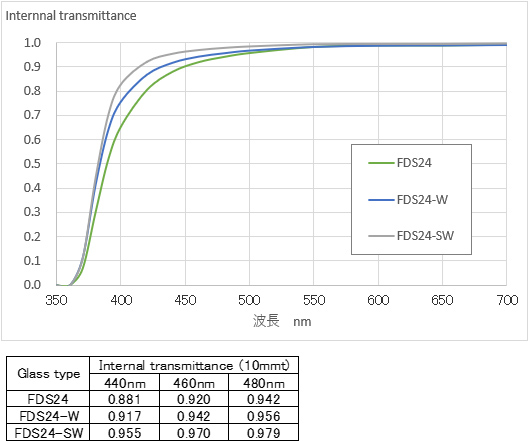
2023 Aug. 22 Introduction of M-TAFD315

Optical glass for aspheric lenses
In addition to MC-TAFD315, we have added M-TAFD315 to our lineup.
In addition to optical glass for cold-processed preforms, we can also provide glass mold lenses.
In addition to the conventional M-TAFD305, M-TAFD315 can also be selected for large lenses (approximately φ25 or more in outer diameter) that use cold-processed preforms.
2023 Apr. 01 Introduction of TAFD34

Optical glass for polished lenses
TAFD34 (nd=1.85033, vd=42.70) is the same vd as TAFD5G (nd=1.83481, vd=42.72) and has a higher refractive index.
It also has good transmittance characteristics (coloration code λ70=370nm) and can be used for various optical products.
2023 Mar. 01 Introduction of NBFD38

Optical glass for polished lenses
We will release NBFD38 (nd=1.65253, νd=39.48) with very large anomalous dispersion in the near-infrared region.
It is a glass that considers both optical performance and chemical durability.
Suitable for cameras that use near-infrared rays.
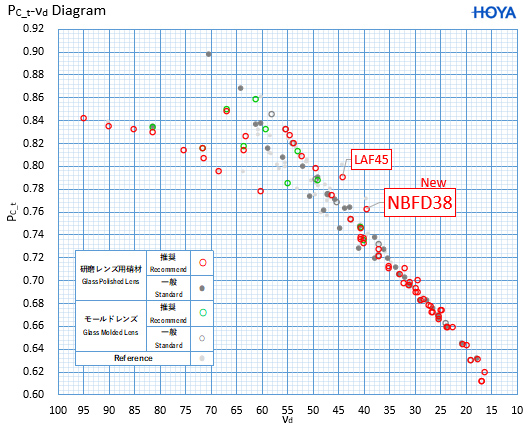
2022 Dec. 12 Introduction of MC-TAFD315

Optical glass preforms for aspheric lenses
MC-TAFD315 (nd:1.85136 νd:40.07) is a glass with improved GMO press moldability of MC-TAFD305.
It can be press-molded at lower temperatures than MC-TAFD305, and the molding range is wider.
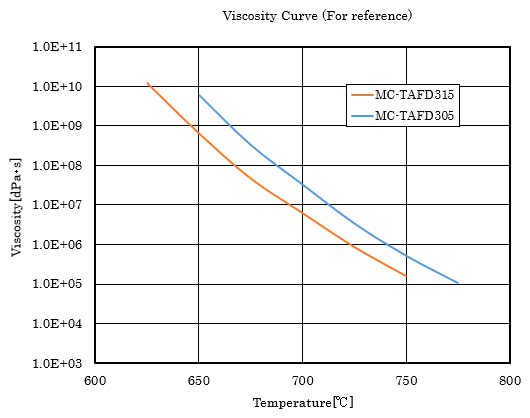
2022 Dec. 12 Introduction of TAC8P,FDS90-SGP

Glass for high-precision polished lenses
TAC8P and FDS90-SGP have a standard tolerance of νd±0.4% and are glasses that can meet high precision requirements.
Refractive index dispersion properties are adjusted.
There is no change in other characteristics.
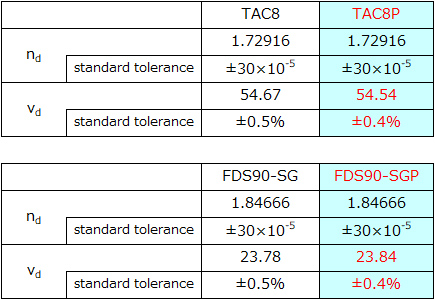
2022 Nov. 15 Introduction of LAF45

Optical glass for polished lenses
LAF45 (nd=1.61396, νd=44.29) is a glass with extremely large anomalous dispersion in the near-infrared wavelength region.
Suitable for cameras that use near-infrared light such as CCTV.

2022 Nov. 15 Introduction of TAFD35L

Optical glass for polished lenses
Cost reduction has been achieved by reducing expensive rare metal raw material components.
nd, vd, coloration are the same as TAFD35. (nd:1.91082 νd:35.25 λ70/λ5:395/350)
2022 Sep. 05 Introduction of E-FDS3-W

Optical glass for polished lenses
We have greatly improved the transmittance characteristics of the high-dispersion glass material E-FDS3 (nd=2.10420, νd=17.02) with a refractive index exceeding nd=2.1. Characteristics other than transmittance are the same as E-FDS3.
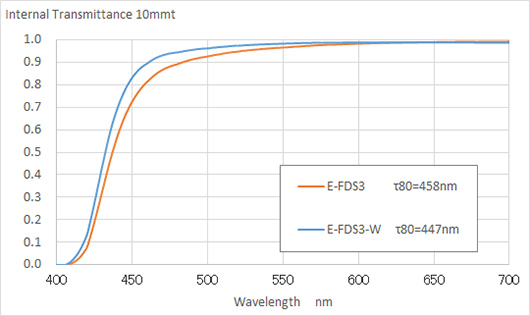
2022 Sep. 05 Introduction of FCD915

Optical glass for polished lenses
Following FCD615, we will release FCD915 (nd = 1.48071, νd = 85.29) .
An optical glass for polished lenses that achieves a high refractive index of nd=1.48071 in the low dispersion region where νd exceeds 85.
It also has anomalous dispersion unique to the FCD series.
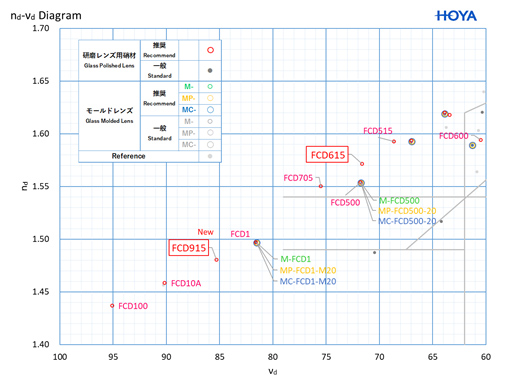
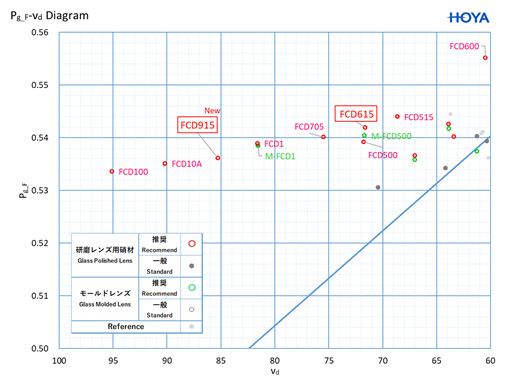
2022 Jul. 11 Introduction of FCD615

Optical glass for polished lenses
FCD615 (nd = 1.57144, νd = 71.61) has been newly added to the FCD series.
It is an optical glass for polished lenses that has abnormal dispersibility, which is a feature of the FCD series, and is effective in correcting chromatic aberration.
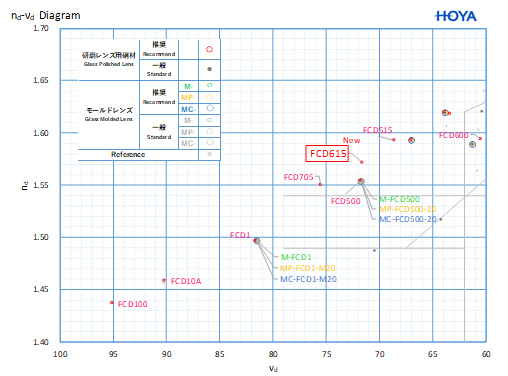
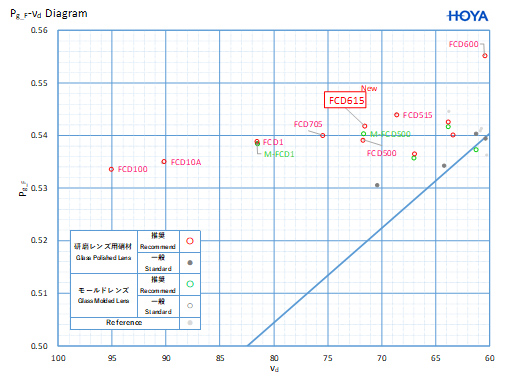
2021 Sep. 01 Excel Catalog Update

Change of glass type classification
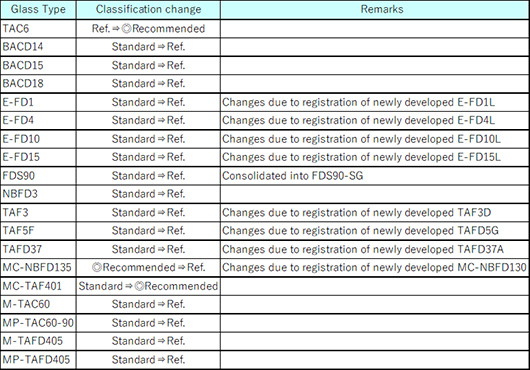
Change of transmittance reference value
The transmittance standard value has been changed due to improvements in production technology and quality stability.
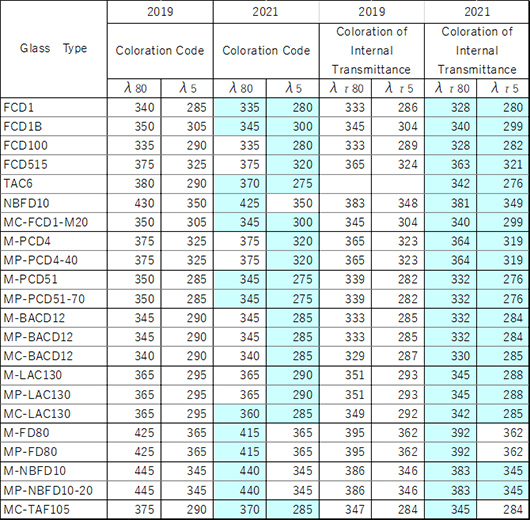
Add dn / dt data
Added dn / dt data for TAC6, LAC8, M-BACD15, MP-BACD15.
2021 Sep. 01 Dimension shape quality of preform for glass mold lens

Update of manufacturing range and dimensional shape quality of preforms for glass mold lenses
Old manufacturing range, dimensional shape quality
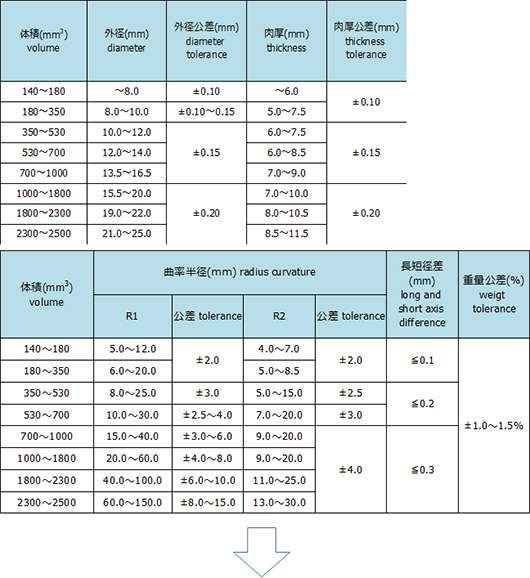
New manufacturing range, dimensional shape quality
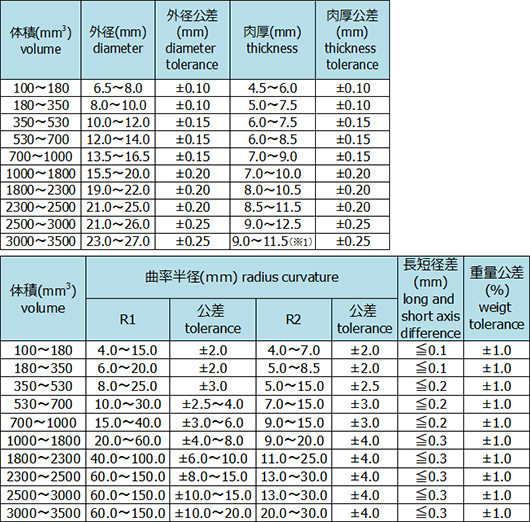
2021 Apr. 21 Introduction of NBFD27

Optical glass for polished lenses
NBFD27 (nd: 1.90110, νd: 27.06, PgF: 0.6072), which has the highest refractive index (nd: 1.90110), has been newly added to the NBFD series (NBFD25, NBFD29, NBFD30, NBFD32), which is characterized by low partial dispersion in the g-line 435.834nm-F-line 486.133nm region.
It is a well-balanced glass material with high refractive index, high light transmission characteristics, and low specific gravity of 3.83.
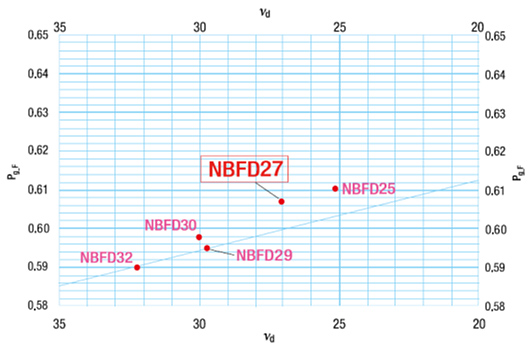
2020 Dec. 04 Introduction of FD270

Optical glass for polished lenses
The new glass FD270 (nd = 1.68430, νd = 26.81) has high partial dispersibility especially in the short wavelength . PgF = 0.6232
It is characterized by high dispersion but low temperature coefficient of refractive index.
dnd/dT(20~40℃)=-3.1×10-6 (ref. E-FD4L(νd=27.53) dnd/dT= 2.6×10-6)
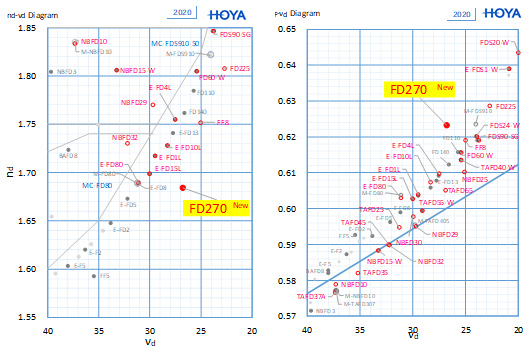
2020 Aug. 03 Introduction of FCD500

Optical glass for polished lenses
For the M-FCD500, MP-FCD500-20, and MC-FCD500-20, which were previously sold as molded lenses and preformed glass for molded lenses, only the refractive index was finely adjusted so that they could be used as spherical lenses. We will sell FCD500.

2020 Mar. 14 Introduction of FDS24-W

Optical glass for polished lenses
The transmittance characteristics of low specific gravity glass material FDS24 (nd = 1.92119, νd = 23.96, d = 3.84) exceeding the refractive index nd = 1.9 have been greatly improved.
The characteristics other than the transmittance characteristics are the same as FDS24.
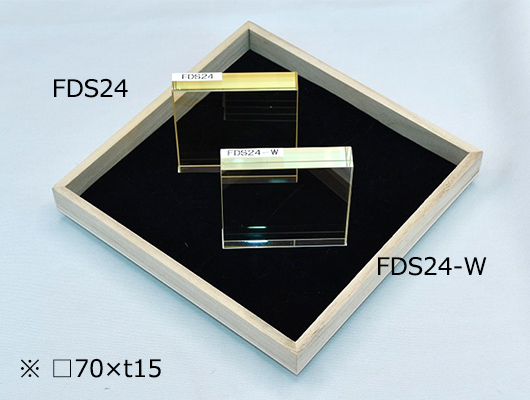
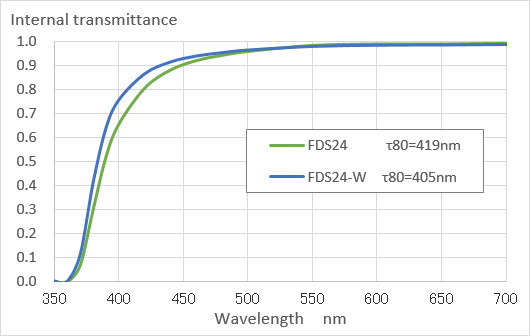
2019 Dec. 11 Introduction of E-FD1L,E-FD4L,E-FD10L,E-FD15L

Optical glass for polished lenses
E-FD1L, E-FD4L, E-FD10L, and E-FD15L have been improved in accuracy with respect to optical characteristics by special melting technology.
Guaranteed by tolerances of refractive index nd ± 20 × 10-5 and Abbe number νd ± 0.3%.
In addition, the use of expensive raw materials has been reduced, resulting in lower prices. Nd and νd are the same as conventional products.
2019 Aug. 01 Introduction of MC-NBFD130

Optical glass preforms for aspheric lenses
MC-NBFD130
In addition to M-NBFD130 and MP-NBFD130, we have lineup of optical glass MC-NBFD130 for cold working preform.
2019 Jun. 14 Excel Catalog Update

Add the display digit number of νd and νe
As the νd tolerance required for products has been reduced, the number of digits displayed for the νd reference value has been written along with the two decimal places and three digits.
For example, for glass types where νd is less than 20, it is possible to specify tolerance with a three-digit numerical value using a three-digit standard value after the decimal point.

The number of wavelength digits has been changed
The number of wavelength digits has been changed to meet the demand for higher precision.
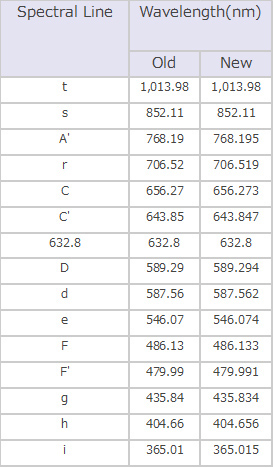
2019 Apr. 24 New Glass Types

Optical glass for aspheric lenses and preforms
M-PCD55AR MP-PCD55AR
M-PCD55AR is a glass molded lens that achieves an acid resistance 1 grade which has never been seen in the middle refractive and medium dispersion regions of nd 1.60 to 1.80 and vd 50 to 60.
It has a small refractive index temperature change (dn / dT) and is suitable for automotive camera lenses. We also manufacture hot process-formed preforms (MP-PCD55AR). Process cost can be reduced.
2019 Apr. 24 New Glass Types

Glass Polished Lenses
NBFD29
It is a glass that achieves the lowest partial dispersion ratio PgF in the νd = 30 area, and is effective for chromatic aberration correction.
Low specific gravity is also characteristic, and it is also effective in reducing the weight of the optical system. In addition, it has good transmittance characteristics and can be used for many applications such as interchangeable lenses.
NBFD32
It is a glass that achieves the lowest partial dispersion ratio PgF in the νd = 32 area, and is effective for chromatic aberration correction.
Low specific gravity is also characteristic, and it is also effective in reducing the weight of the optical system. In addition, it has good transmittance characteristics and can be used for many applications such as interchangeable lenses.
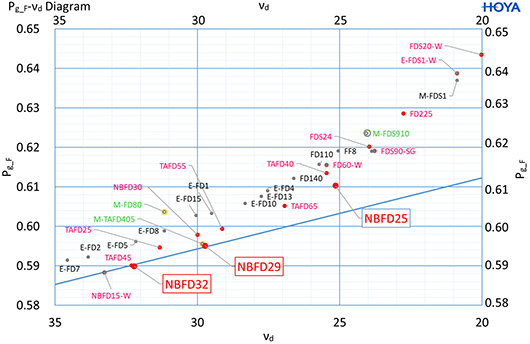
2019 Mar. 12 New Glass Types

Glass Polished Lenses
NBFD25
A glass type which has a refractive index of 1.85 and Abbe number of 25 and realizes low partial dispersion ratio PgF in the same area as FDS90, is effective for correcting chromatic aberration.
It has better transmittance characteristics than FDS90-SG, and it can be used for wide applications such as interchangeable lenses.
2019 Feb. 28 New Glass Types

Glass Polished Lenses
TAFD55-W
The transmittance characteristics of TAFD 55 (nd = 2.00100, νd = 29.13) exceeding the refractive index nd = 2.0 have been greatly improved.
Characteristics other than transmittance are the same as for TAFD55.
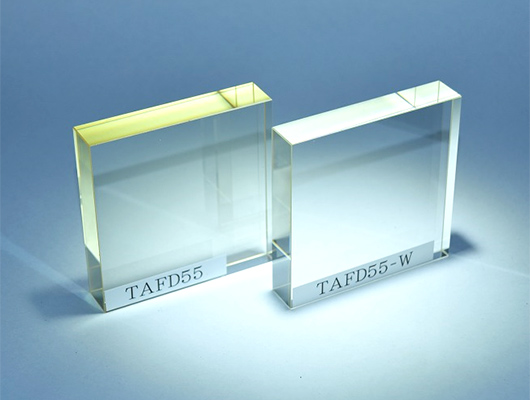
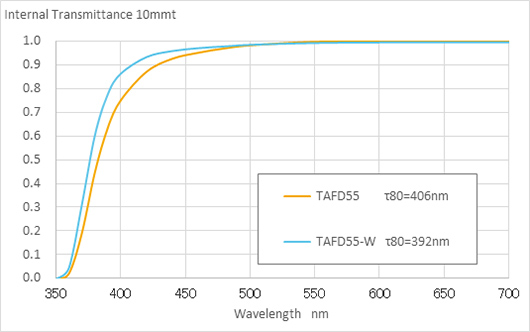
2018 Dec. 15 New Glass Types

Glass Polished Lenses
TAFD40-W
The transmittance characteristics of TAFD 40 (nd = 2.00069, νd = 25.46) exceeding the refractive index nd = 2.0 have been greatly improved.
Characteristics other than transmittance are the same as for TAFD40.
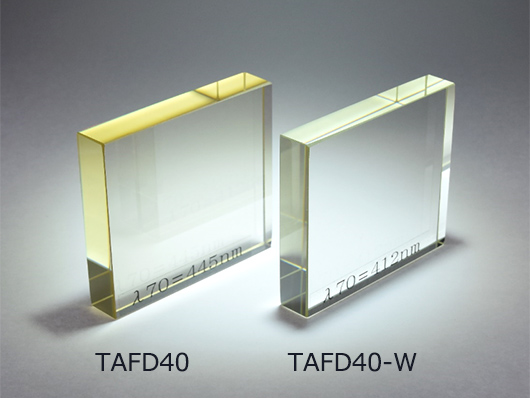
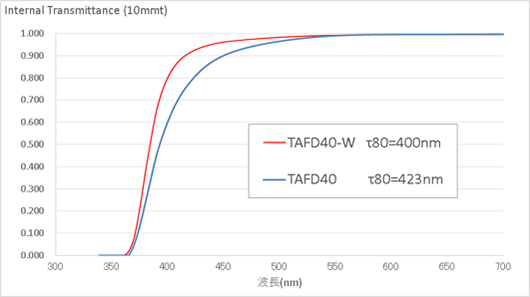
2018 Sep. 06 Notice: The technical problems of the website and its restoration

Dear Customers
Due to server problems, you might have difficulty getting access to our website during the period below.
We apologize for any inconvenience caused by this server problems.
August 29, 2018, 4:03 p.m. - August 30, 2018, 1:00 a.m. (PST)
August 30, 2018, 4:58 p.m. - August 30, 2018, 5:13 p.m. (PST)
August 30, 2018, 6:57 p.m. - August 30, 2018, 7:22 p.m. (PST)
We have already solved the problems, been running it as usual.
If anyone who contacted us in the period and not have any response yet, please contact us again.
We apologize for any inconvenience caused by this development.
Thank you for your cooperation.
2018 Jul. 17 New Glass Types

Glass Polished Lenses
FDS20-W achieved high dispersion(vd=20.02) more than FDS90(vd=23.78) without decline of spectral transmission.
Because FDS20-W has a property of low density(Specific Gravity=3.37), contribution to the weight saving of lens can be expected.
2018 Jun. 12 cooling velocity and refractive index by MC-glass types

In production of non-spherical-power lens by mold press, last refractive index changes on annealing condition. Amount of refractive index change depending on wavelengths is different, it is indicated by catalog data of βC, βd, βF, βg. For your information, annealing condition of MC-glass type and result of constants of dispersion formula and estimated residual stress birefringence are indicated. Residual stress birefringence was calculated using following formula.

→Excel file of reference information can be downloaded here.
2018 Apr. 01 New Glass Types

Glass Polished Lenses
It is a glass with an extremely high partial dispersion ratio (PgF = 0.555) in the νd = 60 area, which have no abnormal dispersion material so far.
And in near infrared spectrum, FCD600 also shows unprecedented partial dispersion ratio and can be used for high-precision correction of chromatic aberration over a wide range of wavelengths.
2017 Dec. 26 New Glass Types

Glass Polished Lenses
As low partial dispersion ratio glass in vd=30 range, a sharp lightweight be realized,
and with excellent transmittance and durability, it can be widely used in many fields.
2017 Sep. 15 We exhibited at CIOE 2017 (Shenzhen, China).

The 19th China International Optoelectronic Expo 2010 was held at CIOE 2017 in Shenzhen, China from Wednesday, September 6th to Saturday, 9th.
We highly appreciate all visitors who visited our booth.
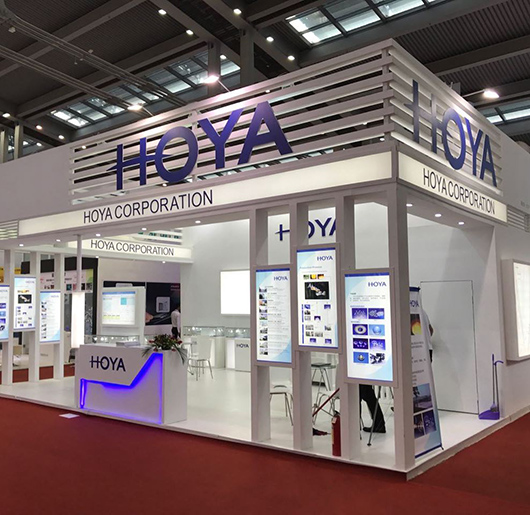
2016 May. 31 New Glass Types

Glass Polished Lenses
Comparing with TAFD30, TAFD32 has same vd value with close nd value,
while exclude the component of Ta, become lighter and lower cost.
High refractive index( nd=2.05) , high transmission with low dispersion and
high environmental resistance, could be widely use in various applications.
The vd value 16.48 which more extreme than FDS18, with high dispersion,
while sustain high transmittance.
2014 Jul. 22 NRP
®- published in Nihon Keizai Shimbun

Our NRP® was published in the Nihon Keizai Shimbun (Japan Economic News post) dated 21 July 2014.
Our previous processing of lens material (RP, reheat-pressed product) was molded to a predetermined size that included a flap zone, has been used over the years for spherical glass lenses and was manufactured through the process of grinding and polishing.
The NRP® process that we developed produces lens material shape accuracy improvement (three times higher precision of RP), surface defects less than 1/3 and thickness variation accuracy improvement (5 times over the current company standard) which could significantly reduce the allowance of polishing lens and reduce the processing fluctuation.
For more information, please refer to the Contact Us on this site or contact our sales representatives by phone at +81-42-546-2520.
It should be noted that, "NRP" is a registered trademark of HOYA CORPORATION.
2012 May. 07 Arrival thanks "Lens Expo 2012"

Thanks for yours sincerely coming "Lens Expo 2012"Apr. 25th to 27th, 2012, in Pacifico Yokohama.
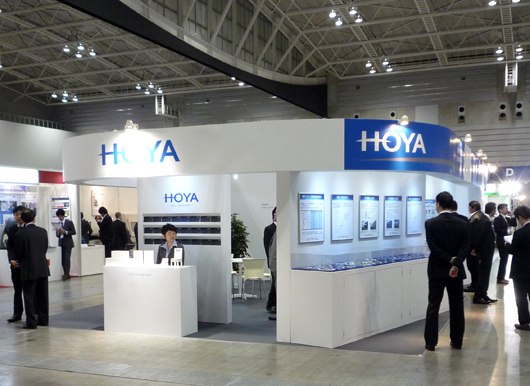
2012 Mar. 23 Attending "Lens Expo 2012"

We are pleased to inform our dearest customers and whom may concernsthat we will attend Lens Expo 2012 which would be held at Pacifico Yokohama,
And we are sincerely looking forward to your visiting.
Time: 25th~27th April, 2012 10:00am-5:00pm
Location: Pacifico Yokohama
Booth: G-1
In the Expo, we would present our new series of cold processing preforms (MC-FCD500-20, MC-TAF31-15); improved spectral transmission with high dispersion optical glasses (FD60-W, NBFD15-W) and all kinds of aspheric lens use optical glasses, lens polishing use optical glasses.
2011 Sep. 12 Arrival thanks "The 13th China International Optoelectronic Expo".

Thanks for yours sincerely coming from various countries and cities visiting our Sept 6th to 9th, 2011, in China International Optoelectronic Exposition(CIOE).
We are looking forward to see you next year again.
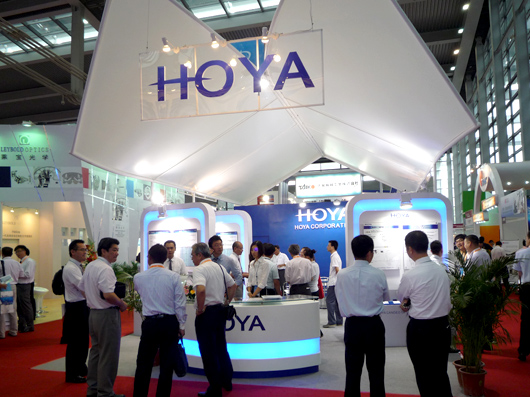
2011 Jul. 06 "The 13th China International Optoelectronic Expo".

The China International Optoelectronic Exposition (CIOE) is a worldwide renowned optoelectronic field exhibition.
This year, the 13th CIOE would be held in Shenzhen Convention& Exhibition Center from September 6th to 9th , 2011 over a total exhibition area of 100,000 square meter. There would be almost 3000 worldwide exhibitors expected to attend.
We, HOYA Group, are pleased to inform our dearest customers and whom may concerns that we will be attending this year to present our most advanced optoelectronic technologies and innovations in the show box 9331( 9th Entry spot), and we are looking forward to your visiting.
<Related Link>
"The 13th China International Optoelectronic Expo"TOP PAGE 
2011 Apr. 20 High-Transmission, High-Refractive Index and High-Dispersion Optical Glass [ FDS90-SG ]

The currently recommended glass FDS90, is widely use as a typical high refractive optical glass with high dispersion. However, this glass type has its specific coloration, many of our customers requested the improvement of its transmission.
In order to response the request of our valuable customers, HOYA was devoted to investigate, and finally come to the result of establishing the stablized production technology of the following high transmission optical glass.
We named it as 「FDS90-SG」 (SG:Special Glass, which is particularly for the improvement of transmission.)
This product is positioned as a contribution to the high performance, high function and high quality of optical products.
In addition, only transmission is changed, without any change of the composition of glass and raw material.
Also, the price will be same as current FDS90.
Specifications of Transmission
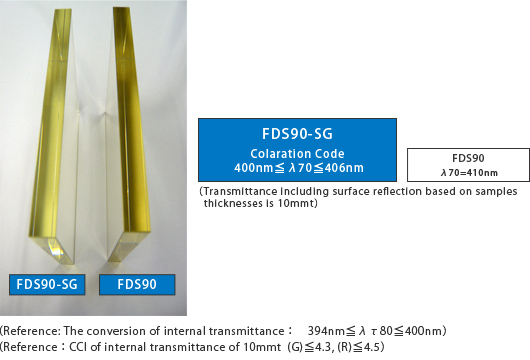
Other Properties
- Standard specifications of refractive index::1.84666 ±30×10-5(Premier specification:1.84666 ±20×10-5)
- Standard specifications of abbe-number:23.78 ±0.5% (Premier specification:23.88 ±0.3%)
- Other chemical properties, thermal properties, mechanical properties and gravity are equivalent to FDS90
PDF Feature Form
Please reference to the following PDF for the standard value of FDS90-SG and Premier νd standard.
For further information of Premier νd standard of FDS90-SG, please visit "Consultation" of our website or contact the following operation branches.
Japan [+81]
〒196-8510, 3-3-1 Musashino, Akishima, TokyoCity
3-3-1Musashino, Akishima-shi, Tokyo 196-8510, Japan
TEL:(042)546-2520 (glass material)、 (042)546-2518 (spherical and aspherical lens)
FAX:(042)546-2097(general)
ASIA・Europe HOYA OPTICAL(ASIA)Co,LTD. [+852]
Suite 3101-2,Tower 6, The Gateway, 9 Canton Road, Tsim Sha Tsui, Kowloon, Hong Kong
TEL:(2723)6883 FAX:(2723)6928
2011 Apr. 20 New Glass Types

Glass Polished Lenses
FCD100 (low dispersion and anomalous dispersion glass)
(low dispersion and anomalous dispersion glass)
FCD100 is an extremely low dispersion optical glass equivalent to fluorite (CaF2).
Relying on technological innovation, we have successfully launched the mass production of high-performance optical glass at the apex of the FCD family.
Combining it with optical glass of high refractive index allows us to achieve unprecedented advanced chromatic aberration correction.

TAFD55 (high refractive index and low dispersion glass)
(high refractive index and low dispersion glass)
TAFD55 is an optical glass that achieves a high refractive index exceeding nd = 2.0 and boasts an Abbe number above νd = 29. Moreover, it limits the type of rare metal materials used to obtain maximum cost performance.It also exhibits outstanding spectral transmission, making it the best choice in lenses for high-performance digital products.
TAFD33 (high refractive index / low dispersion glass)
(high refractive index / low dispersion glass)
TAFD33 is a new high-performance optical glass, which enjoys a high refractive index that exceeds nd = 1.88 and an Abbe number over νd = 40. It achieves low cost by reducing the use of expensive rare metal materials.
PCD51 (low density and low dispersion glass)
(low density and low dispersion glass)
PCD51 is a low dispersion optical glass, featuring excellent chemical durability and low specific gravity.This is a high-performance glass especially suited for reducing optical weght.
Glass Molded Lenses
M-TAFD307 (high refractive index and low dispersion glass material for molded optical lenses)
(high refractive index and low dispersion glass material for molded optical lenses)
M-TAFD307 is a glass molding material with a high refractive index made from M-TAFD305, which contributes greatly to high-power lens designs. Moreover, its Abbe number is equivalent to that for M-NBFD10, and it can also be used as a high refractive index glass.
We are also able to provide aspheric lenses with the same quality as that of M-TAFD305.
M-FDS1 (high refractive index and high dispersion glass material for molded optical lenses)
(high refractive index and high dispersion glass material for molded optical lenses)
M-FDS1 is a glass molding material whose refractive index properties equal those of E-FDS1.
With the use thereof, the number of choices for high refractive index and high dispersion aspheric lenses ranging between M-FDS2 and M-FDS910 has increased.
This enables us to meet a wide variety of needs for high-power lenses.
M-LAC8 、M-LAC14
、M-LAC14 (low dispersion glass material for molded optical lenses)
(low dispersion glass material for molded optical lenses)
M-LAC8 and M-LAC14 were created to respond to the need for high-performance lens designs more efficient than those for M-LAC130. As a result, the current TAFD~TAC lineup of aspheric lenses featuring a high refractive index and low dispersion has been extended to the LAC series.
Heat Process PF
New product lineup of preforms for precision molding (Precision Gob)
We have prepared the following list of glass preforms for precision molding. (Please take note that the preforms marked by the suffix □ □ □ have a different refractive index from molded lenses (MO) designated by the prefix (M-) in the catalogue. )
The following are the ordinary glass types
Cold process PF
MC-TAF1 (high refractive index and low dispersion preforms for precision molding)
(high refractive index and low dispersion preforms for precision molding)
MC-TAF1 is a glass molding material with a high refractive index and low dispersion, possessing refractive index properties corresponding to those of optical glass TAF1.
Highly accurate pressing at low temperatures is possible since the glass transition temperature (Tg) of MC-TAF1 is substantially lower
than that of TAF1.
New product lineup
We have prepared the following list of glass preforms for precision molding (Precision Surface).
The following glass types are used in the production of high-precision aspheric lenses.
(Please take note that the preforms marked by the suffix □ □ □ have a different refractive index from the molded lens (MO) designated by the prefix (M-) in the catalogue.
The following are the ordinary glass types
2011 Mar. 24 “LENS EXPO 2011”.

We will participate in the “LENS EXPO 2011” and you will be welcome to our booth.
Date: April 20 (Wed)~22 (Fri), 2011
Venue:PACIFICO YOKOHAMA, Yokohama, Japan
At this exhibition, we’ll introduce new members of the “H-series” optical glass types and low melting point glass.
We will also present "Optical Glass materials (blanks for glass lenses, preforms for precision moldings)" and "Optical Lenses (aspherical, spherical)" adopting those new glass types.


















































